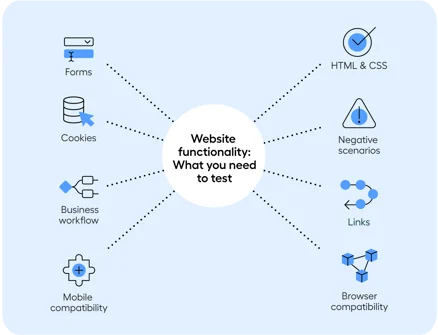It’s not only a technical requirement to make sure your website works as intended; user experience, conversions, and search engine rankings all depend on it. Thorough functionality testing is your safety net whether you’re launching a new website or modifying an old one. This post will show you how to test website operation properly, quickly, comprehensively, and without sacrificing any functionality.
What is Website Functionality Testing?
A Quality Assurance procedure called website functionality testing makes that all of a website’s components operate as intended. Contact forms, shopping carts, broken links, and responsive layouts are all examples of applications where this type of testing mimics actual user behavior to find problems before they become obvious.
It’s an essential phase in the creation and continuous upkeep of websites.
Also Read: What Network is 0995? Understanding the 0995 Mobile Network in the Philippines
Why Functional Testing Matters
Here’s what effective website functionality testing helps you achieve:
- Boost User Experience: Ensure seamless navigation and interactivity.
- Enhance SEO Rankings: Google penalizes broken links, poor page speed, and usability issues.
- Reduce Bounce Rates: A glitch-free site keeps visitors engaged.
- Increase Conversions: Trust grows when everything works as expected.
- Maintain Security: Find and fix vulnerabilities before they’re exploited.
Key Areas to Test on a Website
Let’s dive into what exactly needs to be tested:
1. Forms and Input Fields
Forms are where users take action—signing up, logging in, or reaching out. You should test:
- Form submission with valid and invalid inputs
- Field validations (e.g., email format, required fields)
- Success and error messages
- Backend data capture and storage
- Confirmation emails or redirects
2. Navigation and Links
Test all internal and external links:
- Menu bar and footer links
- In-page anchor links
- Breadcrumb trails
- Redirects and canonical tags
- Check for broken links using tools like Screaming Frog or Ahrefs
3. Interactive Elements
Anything users can interact with should be thoroughly tested:
- Sliders, accordions, tabs, pop-ups
- Search functionality
- Filters and sorting options
- Drag-and-drop interfaces
- Hover states and animations
4. Login/Authentication Systems
Test security and usability of user login features:
- Sign-up and login workflows
- Password reset and email confirmation
- CAPTCHA validation
- Session management (timeout, logout, multiple logins)
5. E-Commerce Functionality (If Applicable)
If your site includes a shopping experience, validate:
- Product listings and filters
- Shopping cart functions
- Payment gateway integration
- Order confirmation and emails
- Inventory updates
6. Content Display
Visual consistency and content accuracy matter:
- Headings, paragraphs, and lists
- Images load correctly and are optimized
- Responsive design across all devices
- Browser compatibility (Chrome, Safari, Firefox, Edge)
7. Page Load Speed
Fast-loading pages are crucial for SEO and UX. Use:
- Google PageSpeed Insights
- GTmetrix
- Lighthouse in Chrome DevTools
Fix bottlenecks such as:
- Unoptimized images
- Render-blocking resources
- Excessive JavaScript
How to Perform Website Functionality Testing (Step-by-Step)
Here’s a practical process you can follow:
Step 1: Define Scope and Requirements
Start by identifying the core functionalities and pages that need testing. Align with business objectives to prioritize critical user flows.
Step 2: Prepare Test Cases and Scenarios
Document test cases that cover expected behaviors and edge cases. Include inputs, steps to reproduce, and expected outcomes.
Example:
- Test Case: Contact form submission
- Input: Valid name and email
- Expected Result: Thank-you message and confirmation email sent
Step 3: Choose the Right Testing Tools
Use both manual and automated testing tools depending on your needs.
Manual testing is ideal for exploratory testing, visual elements, and user interactions.
Automated testing is best for repetitive tasks. Consider:
- Selenium
- Leapwork
- Cypress
- TestCafe
- Playwright
Step 4: Execute Tests
Run your test cases on multiple devices, browsers, and screen resolutions. Take screenshots and record bugs in a centralized QA tool like Jira, TestRail, or ClickUp.
Step 5: Log Issues and Retest
Prioritize bugs based on severity and impact. After fixing them, run regression tests to make sure nothing else broke in the process.
Step 6: Continuous Monitoring
Post-launch, keep testing. Functional issues can arise from content changes, plugin updates, or third-party API failures.
Use monitoring tools like:
- Pingdom (Uptime)
- Google Search Console (Coverage issues)
- Hotjar (User behavior)
Best Practices for Functional Website Testing
- Always test in a staging environment first.
- Automate high-volume and regression tests.
- Validate user journeys, not just components.
- Test on real devices when possible (or use emulators like BrowserStack).
- Maintain a clear bug-reporting format for developers.
- Don’t skip negative testing (what happens when users do the wrong thing).
Common Mistakes to Avoid
- Ignoring mobile functionality
- Skipping edge cases and invalid inputs
- Not testing across different browsers
- Over-relying on automation without human verification
- Failing to update tests after site changes
Conclusion
Testing the functioning of websites is an ongoing commitment to quality, user experience, and performance rather than a one-time event. In addition to identifying issues early, a methodical and comprehensive strategy will provide a strong foundation for SEO, conversions, and user trust.
In today’s fast-paced digital environment, being able to efficiently test website functionality is crucial, regardless of your role—developer, QA engineer, or business owner.
Frequently Asked Questions (FAQ)
Website functionality testing is the process of checking whether all components of a website—like forms, buttons, links, and interactive elements—work as expected. It ensures that the site performs correctly under various user conditions and devices.
Functionality testing is crucial because it helps deliver a smooth user experience, ensures all features work properly, boosts SEO performance, and prevents revenue loss caused by broken features or errors.
Popular tools for website functionality testing include:
Selenium (automation)
Leapwork (no-code automation)
Cypress (JavaScript-based)
BrowserStack (cross-browser testing)
Google PageSpeed Insights (performance testing)
Yes, you can automate many parts of functionality testing using tools like Selenium, Cypress, or Leapwork. Automation is ideal for repetitive tasks and regression testing, though some visual and usability elements are still best tested manually.
Functional testing checks what the system does—like logging in or processing a payment.
Non-functional testing checks how the system performs—such as speed, scalability, or usability.






